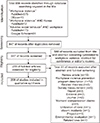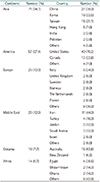Abstract
Objectives
Research on workplace violence has been conducted, but rarely has been organized systematically. In this study, we summarize the definition and classification of workplace violence studies and review the literature on workplace violence.
Methods
Using academic search engines PubMed, Google Scholar and DBpia, we found 856 papers including “workplace violence” and “adverse social behavior” AND workplace in the title published until December 2018, and 208 papers were selected. The selected papers were classified by continent and country, year of publication, occupation, classification criteria of workplace violence, and research topic.
Results
By country, the number of articles in the United States was the most with 40 (19.2%), followed by China 27 (13%), Korea 16 (7.7%), and Taiwan and Australia 15 (7.2%). By job category, healthcare workers accounted for the largest portion with 162 (79.0%) of the total, and 80 of them were conducted on nurses. Other occupations included civil servants, manufacturing workers, toll collectors and wageworkers. Among the classification methods of workplace violence, 147 (67.4%) articles were classified as type and there was a difference in the type of violence defined for each article. In the research topic, 114 (44.2%) articles analyzed the effects of workplace violence, and 105 (40.7%) articles describe the prevalence and characteristics of workplace violence, and 23 (8.9%) articles analyzing the causes of violence.
Figures and Tables
Table 2
Occupational distribution of participants in published workplace violence studies

Values are presented as number (%).
*Addiction treatment center staff, emergency medical workers, firefighters, police officers, social worker, educational worker, female worker, adolescent worker, retail and service workers, fishery worker, and sex worker.
†Call center worker, bank clerk, substitute driver, toll collector, and manufacturing worker.
References
1. Kim WB. The violence at workplace: focusing on the influence of work conditions. Korean Criminol Rev. 2009; 20:173–201.
2. Krug EG, Mercy JA, Dahlberg LL, Zwi AB. The world report on violence and health. Lancet. 2002; 360:1083–1088.

3. Chappell D, Martino VD. Violence at work. 3rd ed. Geneva: International Labour Organization;2006.
4. International Labour Organization. World Health Organization. Framework guidelines for addressing workplace violence in the health sector. Geneva: International Labour Organization;2002.
5. Centers for Disease Control and Prevention. National Institute for Occupational Safety and Health. Current Intelligence Bulletin 57: violence in the workplace. Cincinnati: National Institute for Occupational Safety and Health;1996.
6. University of Iowa Injury Prevention Research Center. Workplace violence: a report to the nation. Iowa City: University of Iowa;2001.
7. California Division of Occupational Safety and Health. Guidelines for security and safety of health care and community service workers. San Francisco: California Division of Occupational Safety and Health;1998.
8. Eurofound. The 6th European working conditions survey questionnaire. Loughlinstown: Eurofound;2015.
9. Hosseinikia SH, Zarei S, Najafi Kalyani M, Tahamtan S. A crosssectional multicenter study of workplace violence against prehospital emergency medical technicians. Emerg Med Int. 2018; 2018:7835676.

10. Najafi F, Fallahi-Khoshknab M, Ahmadi F, Dalvandi A, Rahgozar M. Human dignity and professional reputation under threat: Iranian Nurses' experiences of workplace violence. Nurs Health Sci. 2017; 19:44–50.

11. Shafran-Tikva S, Zelker R, Stern Z, Chinitz D. Workplace violence in a tertiary care Israeli hospital: a systematic analysis of the types of violence, the perpetrators and hospital departments. Isr J Health Policy Res. 2017; 6:43.

12. Sun T, Gao L, Li F, Shi Y, Xie F, Wang J, et al. Workplace violence, psychological stress, sleep quality and subjective health in Chinese doctors: a large cross-sectional study. BMJ Open. 2017; 7:e017182.

13. Oh H, Uhm DC, Yoon YJ. Workplace bullying, job stress, intent to leave, and nurses' perceptions of patient safety in South Korean hospitals. Nurs Res. 2016; 65:380–388.

14. Imran N, Jawaid M, Haider II, Masood Z. Bullying of junior doctors in Pakistan: a cross-sectional survey. Singapore Med J. 2010; 51:592–595.
15. Rayner C, Hoel H. A summary review of literature relating to workplace bullying. J Community Appl Soc Psychol. 1997; 7:181–191.

16. Hershcovis MS, Barling J. Comparing victim attributions and outcomes for workplace aggression and sexual harassment. J Appl Psychol. 2010; 95:874–888.

17. Gelfand MJ, Fitzgerald LF, Drasgow F. The structure of sexual harassment: a confirmatory analysis across cultures and settings. J Vocat Behav. 1995; 47:164–177.

18. Neuman JH, Baron RA. Aggression in the workplace: a socialpsychological perspective. In : Fox S, Spector PE, editors. Counterproductive work behavior: investigations of actors and targets. Washington, DC: American Psychological Association;2005. p. 13–40.
19. Kivimaki M, Virtanen M, Vartia M, Elovainio M, Vahtera J, Keltikangas-Jarvinen L. Workplace bullying and the risk of cardiovascular disease and depression. Occup Environ Med. 2003; 60:779–783.
20. Zhang SE, Liu W, Wang J, Shi Y, Xie F, Cang S, et al. Impact of workplace violence and compassionate behaviour in hospitals on stress, sleep quality and subjective health status among Chinese nurses: a cross-sectional survey. BMJ Open. 2018; 8:e019373.

21. Xu T, Magnusson Hanson LL, Lange T, Starkopf L, Westerlund H, Madsen IEH, et al. Workplace bullying and workplace violence as risk factors for cardiovascular disease: a multi-cohort study. Eur Heart J. 2019; 40:1124–1134.

22. Yang BX, Stone TE, Petrini MA, Morris DL. Incidence, type, related factors, and effect of workplace violence on mental health nurses: a cross-sectional survey. Arch Psychiatr Nurs. 2018; 32:31–38.

23. Zeng JY, An FR, Xiang YT, Qi YK, Ungvari GS, Newhouse R, et al. Frequency and risk factors of workplace violence on psychiatric nurses and its impact on their quality of life in China. Psychiatry Res. 2013; 210:510–514.

24. Kitaneh M, Hamdan M. Workplace violence against physicians and nurses in Palestinian public hospitals: a cross-sectional study. BMC Health Serv Res. 2012; 12:469.

25. Wu S, Zhu W, Li H, Lin S, Chai W, Wang X. Workplace violence and influencing factors among medical professionals in China. Am J Ind Med. 2012; 55:1000–1008.

26. Magnavita N. The exploding spark: workplace violence in an infectious disease hospital. A longitudinal study. Biomed Res Int. 2013; 2013:316358.
27. Gerberich SG, Church TR, McGovern PM, Hansen HE, Nachreiner NM, Geisser MS, et al. An epidemiological study of the magnitude and consequences of work related violence: the Minnesota Nurses' Study. Occup Environ Med. 2004; 61:495–503.

28. Chen WC, Hwu HG, Wang JD. Hospital staff responses to workplace violence in a psychiatric hospital in Taiwan. Int J Occup Environ Health. 2009; 15:173–179.

29. Ridenour ML, Hendricks S, Hartley D, Blando JD. Workplace violence and training required by new legislation among NJ nurses. J Occup Environ Med. 2017; 59:e35–e40.

31. Morphet J, Griffiths D, Innes K. The trouble with reporting and utilization of workplace violence data in health care. J Nurs Manag. 2019; 27:592–598.

32. Bureau of Labor Statistics. Census of Fatal Occupational Injuries: fatal occupational injuries by event. Washington, DC: Bureau of Labor Statistics;2018.
33. Eisele GR, Watkins JP, Matthews KO. Workplace violence at government sites. Am J Ind Med. 1998; 33:485–492.

34. Groenewold MR, Sarmiento RF, Vanoli K, Raudabaugh W, Nowlin S, Gomaa A. Workplace violence injury in 106 US hospitals participating in the Occupational Health Safety Network (OHSN), 2012–2015. Am J Ind Med. 2018; 61:157–166.

35. Foley M, Rauser E. Evaluating progress in reducing workplace violence: trends in Washington State workers' compensation claims rates, 1997-2007. Work. 2012; 42:67–81.

36. McCall BP, Horwitz IB. Workplace violence in Oregon: an analysis using workers' compensation claims from 1990-1997. J Occup Environ Med. 2004; 46:357–366.
37. Zhang L, Wang A, Xie X, Zhou Y, Li J, Yang L, et al. Workplace violence against nurses: a cross-sectional study. Int J Nurs Stud. 2017; 72:8–14.

38. World Health Organization. Violence and injury prevention: preventing violence. Geneva: World Health Organization;2013.
39. Bureau of Labor Statistics. Nonfatal occupational injuries and illnesses requiring days away from work 2012. Washington, DC: Bureau of Labor Statistics;2013.
40. Occupational Safety and Health Administration. Workplace violence in healthcare. Washington, DC: Occupational Safety and Health Administration;2015.
41. Avander K, Heikki A, Bjersa K, Engstrom M. Trauma nurses' experience of workplace violence and threats: short- and long-term consequences in a Swedish setting. J Trauma Nurs. 2016; 23:51–57.




 PDF
PDF ePub
ePub Citation
Citation Print
Print







 XML Download
XML Download